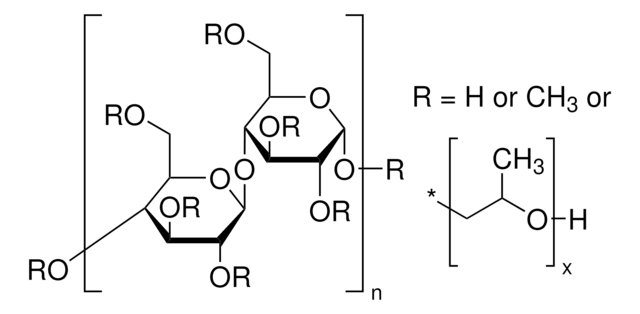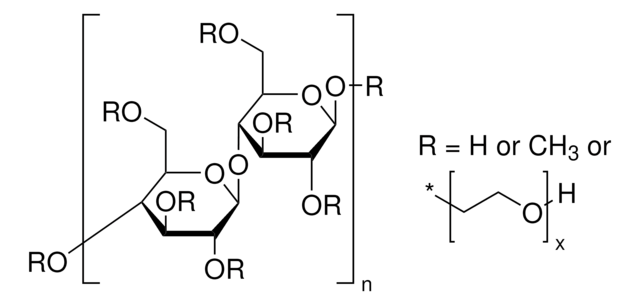435007
Hydroxypropylcellulose
average Mw ~80,000, average Mn ~10,000, powder, 20 mesh particle size (99% through)
Synonym(e):
HPC
About This Item
Empfohlene Produkte
Beschreibung
biological oxygen demand (BOD) 14,000 ppm
Qualitätsniveau
Form
powder
Selbstzündungstemp.
752 °F
Mol-Gew.
average Mn ~10,000
average Mw ~80,000
Verunreinigungen
<5 wt. %
Partikelgröße
20 mesh (99% through)
pH-Wert
5.0-8.5
Grenzflächenspannung Mineralöl
12.5 dyn/cm, 0.1 wt. % in H2O (vs. mineral oil)
Viskosität
250-800 cP, 10 wt. % in H2O(25 °C)(lit.)
Löslichkeit
H2O: insoluble (above 45 °C)
polar organic solvents: soluble
Dichte
0.5 g/mL at 25 °C (lit.)
InChI
1S/C12H20N2/c1-5-12(13)11-7-6-10(14(3)4)8-9(11)2/h6-8,12H,5,13H2,1-4H3
InChIKey
RRHXDYJWVYFMKV-UHFFFAOYSA-N
Suchen Sie nach ähnlichen Produkten? Aufrufen Leitfaden zum Produktvergleich
Allgemeine Beschreibung
Anwendung
Lagerklassenschlüssel
11 - Combustible Solids
WGK
WGK 1
Flammpunkt (°F)
Not applicable
Flammpunkt (°C)
Not applicable
Persönliche Schutzausrüstung
Eyeshields, Gloves, type N95 (US)
Hier finden Sie alle aktuellen Versionen:
Besitzen Sie dieses Produkt bereits?
In der Dokumentenbibliothek finden Sie die Dokumentation zu den Produkten, die Sie kürzlich erworben haben.
Kunden haben sich ebenfalls angesehen
Unser Team von Wissenschaftlern verfügt über Erfahrung in allen Forschungsbereichen einschließlich Life Science, Materialwissenschaften, chemischer Synthese, Chromatographie, Analytik und vielen mehr..
Setzen Sie sich mit dem technischen Dienst in Verbindung.


